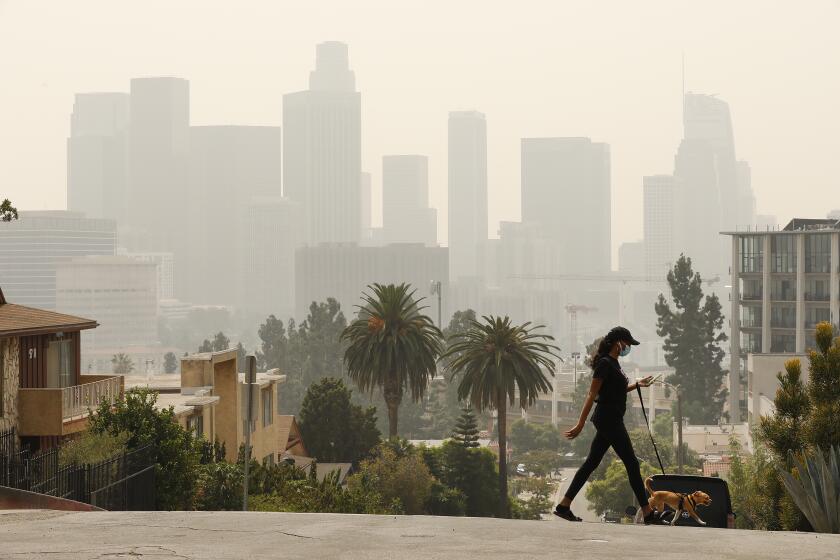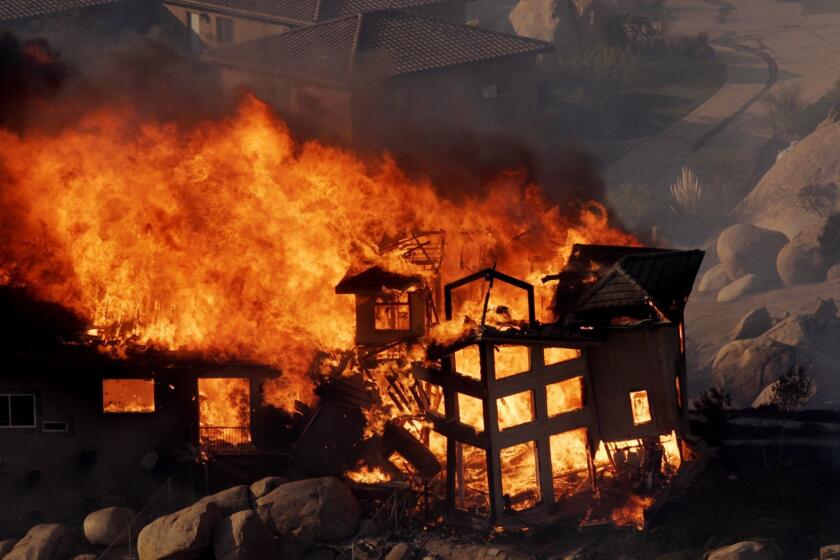After back-to-back wildfires, some Napa winemakers won’t make a 2020 vintage
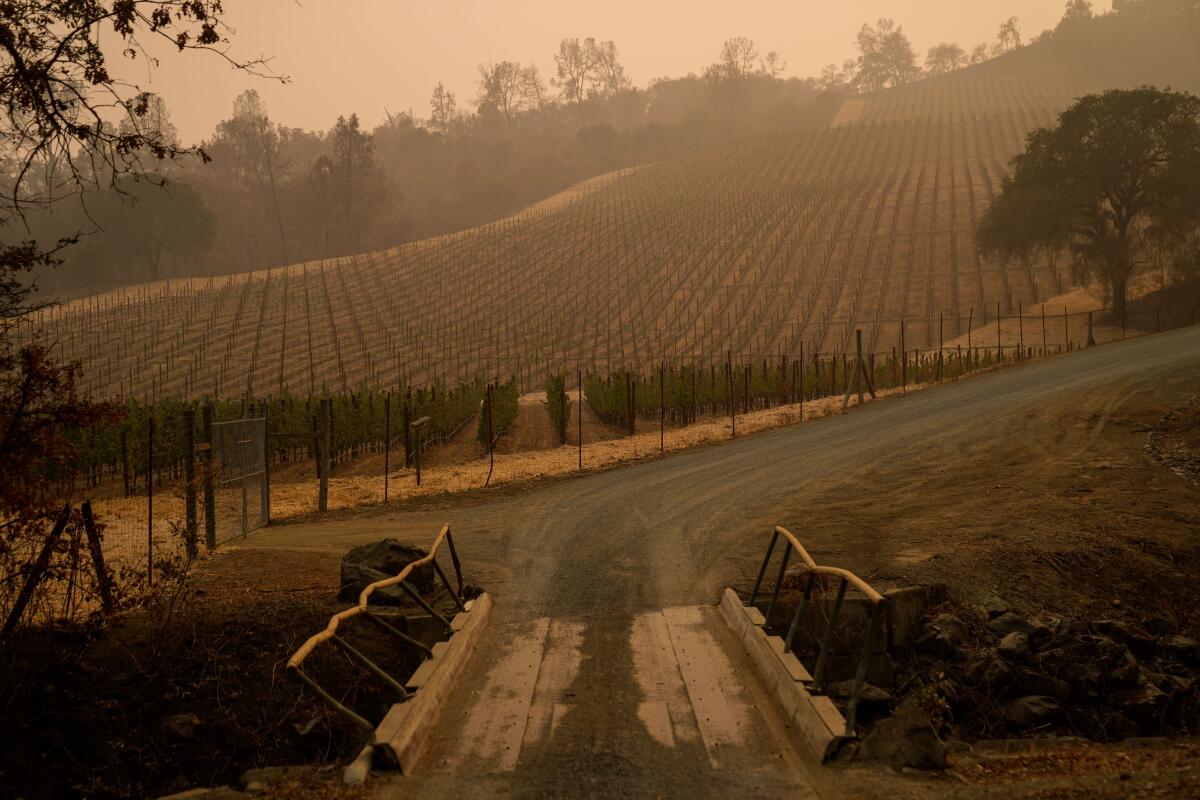
- Share via
ST. HELENA, Calif. — Craig Becker walked among the vines of Somerston Estate in St. Helena and surveyed the rolling hills before him. Less than two months ago, lightning storms sparked fires that lit the ridges around him and tore through the trees, bushes and crops that covered this sprawling piece of land.
The flames rendered the estate’s surviving vines unworkable, spoiled by the thick smoke that sat in the valley and seeped into grapes, turning their flavor to ash. Like several other vineyards here, Somerston has decided not to harvest any fruit from its 2020 vintage due to damage caused by smoke fumes.
“All of them are tainted,” Becker said as he chewed a grape, then spit it out. “I have it on my tongue right now.”
California has been under near-constant siege by wildfires for nearly two months as flames of historic size, intensity and destruction have ignited throughout the state.
Following large, consecutive wildfires in Napa — first the LNU Lightning Complex fire that burned more than 363,000 acres in August, and now the Glass fire that has chewed through more than 51,000 acres — some vintners say harvesting this year’s grapes isn’t worth the time or investment because they can’t be salvaged.
“It’s terrible,” Becker said, hopping into his buggy and driving down a hill to inspect another batch of vines. “You can taste it on the finish.”
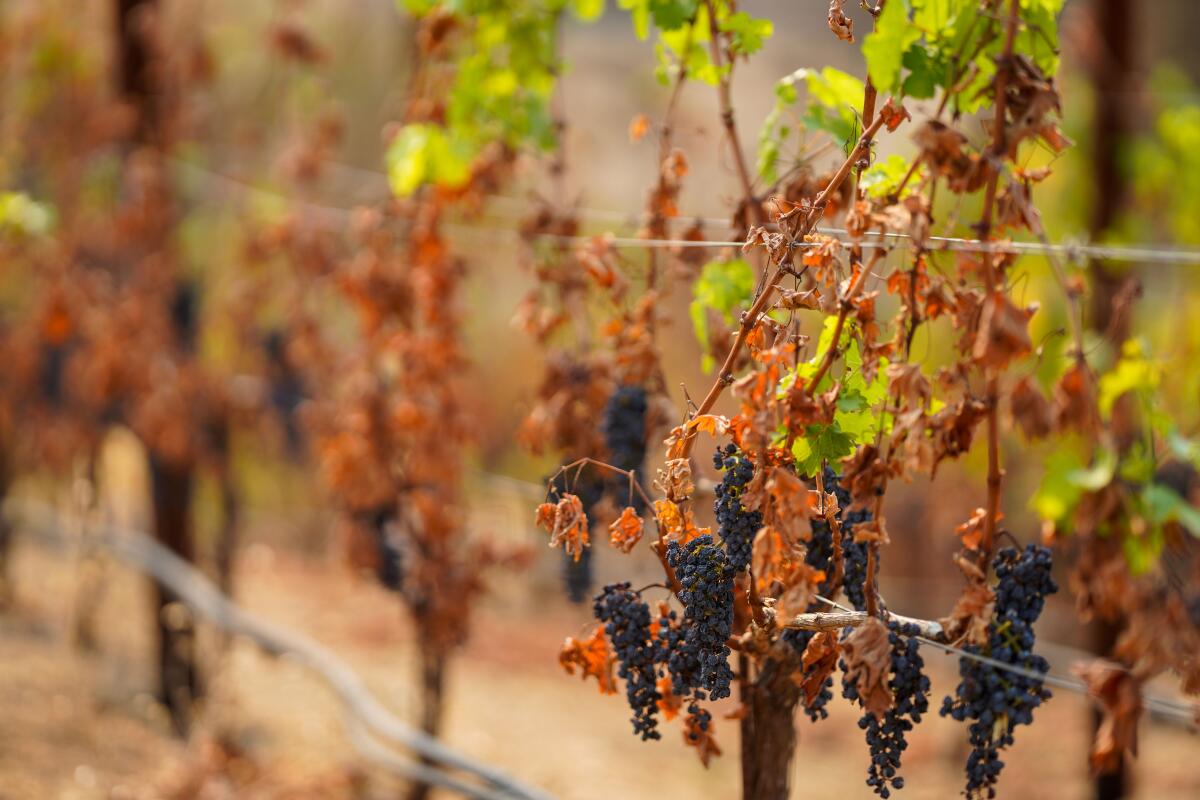
It’s still too early to tell what the full extent of loss will be for winemakers across the state, but some vineyard managers are preparing for the worst. In a traditional fire season, wine country wildfires would occur around mid-October, when for many vineyards, a majority of fruit had already been picked. This year, more fruit remained vulnerable on the vine when smoke set in.
Smoke contains compounds that bind to the skin of grapes and get absorbed into the fruit. The aroma releases throughout the fermentation and aging process, making a seemingly unaffected wine taste more ashy over time. In general, red wines, especially ones made with thin-skinned grapes like Pinot Noir, tend to be most affected.
“This is definitely an industry challenge, but it’s not something that consumers need to worry about. The wineries simply won’t release bad wine,” said Gladys Horiuchi of the Wine Institute.
During a normal fall season, Becker’s employees would be showing tourists and wine lovers around the property and pointing out the different varietals before taking them back inside for a tasting.
Somerston, which covers 1,682 acres of Napa Valley’s eastern Vaca mountain range, hosts 244 acres of vineyards. Nearly 1,400 acres of the estate burned in the Hennessey fire, part of the LNU Lightning Complex.
The estate also chose not to harvest most of its fruit after fires tore through the region in 2017. But the 2020 vintage has higher taint levels, Becker said, ranging from five to 15 times more smoke taint than 2017.
“We have enough wine to bridge the gap,” he said. But the vineyard will likely run out of white wine this year because it has only the 2019 vintage to draw on, he added.
Becker, Somerston’s general manager, said the estate is trying to recoup some of the costs of the August wreckage from insurance. He estimates the vineyard sustained $1.1 million in infrastructure damage alone.
For smaller vineyards, the smoke damage to 2020 vines will be harder to stomach.
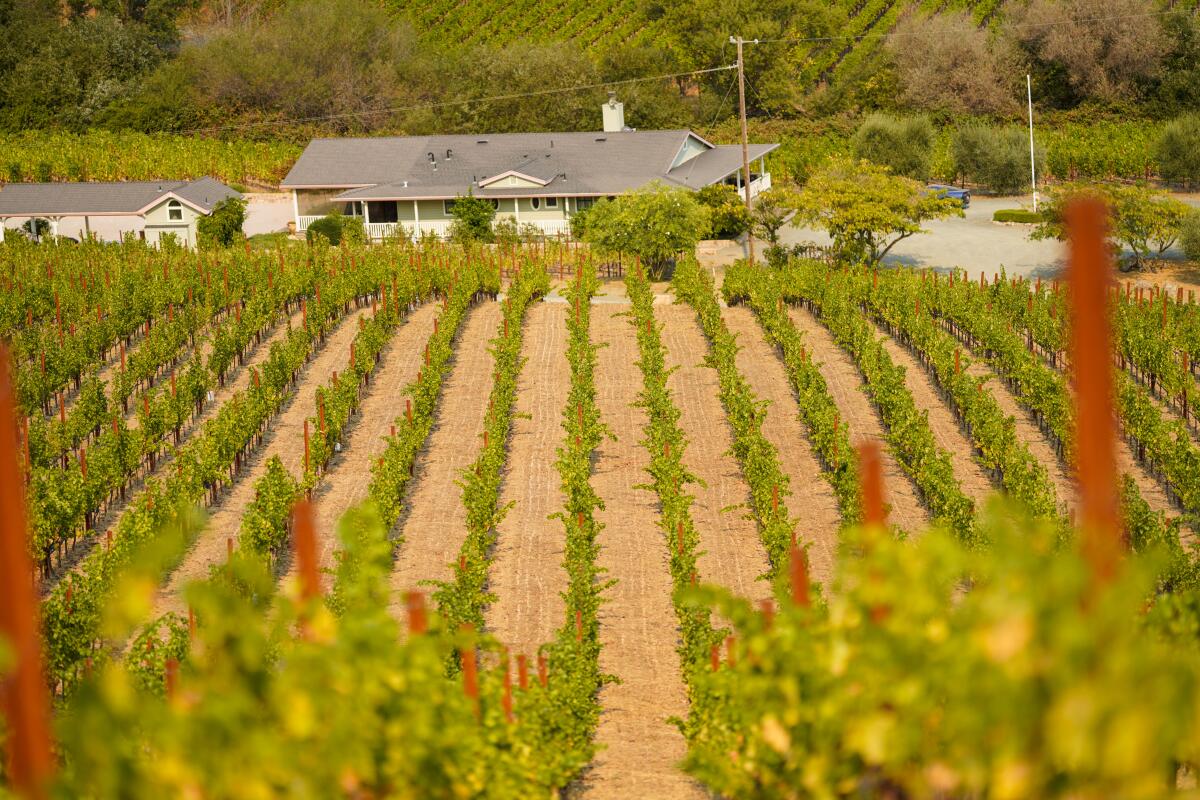
Lamborn Family Vineyards in Angwin announced last month it wouldn’t make a 2020 vintage after the LNU Lightning Complex fire choked its vines. The vineyard produces about 1,800 cases of wine per year with grapes grown on just under 9 acres.
“The fruit tastes really good if you were to pick it from the vine, but the problem is the smoke taint shows itself after fermentation,” said Brian Lamborn, who runs the vineyard with his parents and brother. “Our winemaker did some micro fermentation on fruit from different sections in the vineyard, and there was measurable smoke taint.”
Vineyards as far north as Mendocino County have been battling smoke taint issues for the last four years, said Lewis Perdue, publisher and executive editor of Wine Industry Insight.
“In some cases, the larger wineries which would buy from a lot of different vineyards would simply reject the grapes, and the vineyard owner is kind of stuck,” Perdue said. “Right now, nobody really knows what the extent is going to be.”
For weeks, millions of Californians were smothered by smoke from wildfires. Many worry about long-term health impacts.
Wednesday morning, Lamborn said flames from the Glass fire were the closest any blaze has come to the vineyard. He hasn’t been able to drive into the area to check on the property.
“We do have wines to sell over the next few years, but it’s 2023 that is going to be really problematic,” he said, referring to the year the winery’s 2020 vintage would have been sold. “When you’re in the business of selling wine, and you have a year of no wine to sell, it’s a big deal for a small winery like us. With the whole pandemic going on, and now the wildfires, wine country has really taken a hit.”
The 45-year-old said the family lost its nearly $100,000 investment in this year’s grapes — a cost they can’t easily recover.
“That is something we feel immediately,” he said. “We’re not a bigger vineyard. We are a small family business, and that represents a significant investment for someone of our size.”
The vineyard is looking into alternatives for its sooty grapes, he added, including hand sanitizers, sauces and fruit essence. Still, not every winery or vineyard is going to lose its 2020 crop, Lamborn said.
“It’s not this doom and gloom where wine country isn’t going to be making any wines from 2020,” he said. “There will be some wonderful wines. It’s just that for us it was a tough decision, but one that needed to be made.”
To confirm the smoke damage, grapes have to be tested. But the laboratories that perform tests are backlogged with an unprecedented volume of requests, experts say.
Jason Smith, president of vineyard management firm Valley Farm Management, said results that used to come back within 24 to 72 hours now take about four to five weeks.
ETS Laboratory, a primary company California winemakers turn to for testing, is evacuating its St. Helena branch in the midst of the Glass fire, adding potential delays to results.
“I mean, you can’t even make this up,” said Smith. “It’s just crazy.”
Record heat. Record acres burned. Sky-high air pollution. The extremes California has experienced in recent weeks all have one thing in common: They were made worse by climate change.
Two weeks ago, a coalition of organizations advocating for California, Oregon and Washington winemakers requested support for disaster relief and continued research from Congress through the Wildfire and Hurricane Indemnity Program.
The group said they feared fires “will result in the greatest economic loss, due to a natural disaster, ever suffered by the industry in our states,” according to the letter they sent to officials.
Some winemakers have found creative ways to work with an otherwise spoiled product. When Lindsay Hoopes tasted her 2017 vintage in 2019, she was shocked by the profile that had become “unsaleable” since the last time she tested the batch.
“The wine tasted like an absolute ash tray,” Hoopes said. “It came seemingly out of nowhere. We would never have embarked on processing them if we had known.”
She is still fighting with insurance to cover the costs of some of the loss at Hoopes Vineyard, she said. But a chance meeting with master distiller during a trip to Kentucky provided an unconventional solution that could help her recoup some of what she lost: using the smoky wine for spirits.
A second-generation grower, Hoopes leaned into the charred flavor profile of her wine and used it to make brandy and vermouth. The pivot required additional investment on top of losing expensive crops, but she needed to salvage what she could. With her brandy still aging in the barrel, she hopes to recover at least part of the $2 million she lost in 2017.
“2017 wildfires started the trend of putting your entire year’s revenue at risk,” said Hoopes, who was raised in Napa.
Sitting at a picnic table at her Yountville vineyard, Hoopes explained that the vines behind her were tainted by smoke again this year. She said she plans on using those grapes for brandy and vermouth too.
“More people are affected now,” she said. Thick clouds of smoke hung in the air, migrating from the flames around Calistoga down into the valley where Hoopes has created her “oasis” — a space outfitted with Airstreams, a garden and an animal sanctuary.
“Some people might escape it, but in theory you could be talking about an entire vintage gone.”
Researchers say continued home building in high-risk wildfire areas threatens lives and makes big blazes more likely.
Emma Swain, chief executive of St. Supéry Estate Vineyards & Winery, said the estate is facing a loss of grapes due to smoke from the August fires and the Glass fire. It was able to use grapes from its Rutherford property, Swain said, as well as grapes harvested from its Dollarhide vineyard in Napa’s northeastern hills before the LNU Lightning Complex fire broke out. The rest showed “significant taint.”
“It’s like losing 90,000 cases of Napa Valley wine,” Swain said, adding that the estate had not seen tainted grapes in previous years. “It affects our business for the next three years, and I think that is true for everyone.”
The LNU Lightning Complex posed a bigger threat than the Glass fire, she added, because those fires burned on the estate while the Glass fire has remained miles away.
“The reality is we can’t put something we’re unsure of out. We’re not going to damage our reputation, and I think that’s true of all the reputable brands,” she said. “It’s going to be a big financial loss for a lot of wineries. It’s serious.”
More to Read
Sign up for Essential California
The most important California stories and recommendations in your inbox every morning.
You may occasionally receive promotional content from the Los Angeles Times.
